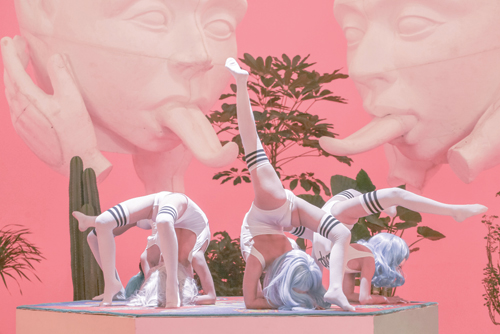Tianzhuo Chen Idolises the Celebrity
At Long March Space, Beijing, China, the artist illustrates his anxiety about the future of his generation
At Long March Space, Beijing, China, the artist illustrates his anxiety about the future of his generation

It is tempting to view the work of Chinese artist Tianzhuo Chen as another illustration of the academic José Esteban Muñoz’s contention that queerness is a futurity-bound phenomenon – a politics of ‘not yet here’ that lies always out of reach. Chen is quickly becoming known for his futuristic, hyper-queer characters that remix Japanese anime and science-fiction conventions with Leigh Bowery-esque costumes. However, as the artist’s first solo exhibition at Long March Space revealed, Chen’s queer futurity operates on another, perhaps more historical, plane: that of religion. More specifically, Chen’s larger project involves constructing a new and fictitious religion that repurposes cultural symbology, collapses sexual norms and worships hedonism.
The exhibition – curiously, viewable by appointment only – inducted the visitor into Chen’s invented religion. At the entrance lay a small sculpture entitled Instrument 3 (2010), consisting of six grey eyeball-shaped objects book-ended by two small Egyptian scarabs. Gold decorative lines emanate from the sculpture on the plinth below, reminiscent of early Christian iconography. In the main gallery, two enormous concrete heads with long tongues rested peacefully like ancient Buddhist ruins (Tainted Kiss, 2014). Neon text attached to each forehead reads, respectively: ‘Salvation’ and ‘Desperation’. Nearby, another neon text piece presented vertical flaming Chinese characters whose English translation read ‘In Hell’, while a sculpture of a divine heterosexual couple copulating sat majestically atop a plinth.

Chen describes his work as an attempt to transcend the self and create ‘a state of madness’. This aim is certainly achieved in the exhibition’s two videos, ADAHA II (2015) and 19:53 (2014). ADAHA II is almost 45 minutes long and presents documentation of the artist’s recent performance at the Palais de Tokyo in Paris with artist and dancer Beio (also featured in 19:53) and the artist collective House of Drama. His deranged aesthetic translates impressively to a theatrical context: one scene sees an androgynous performer in a ballooning bodysuit flailing on the floor singing lyrics such as: ‘Pump the maddafakkin speakers; let my buttplug sing for kilometeres. Fuck me hard fuck me now lick my stick; I suck on Hello Kitty’s big big dick.’ More seductive on screen was 19:53, a short looped video that begins with a woman praying to an unspecified god while holding a wriggling bundle of tiny pink newborn mice in her hands. To an electro-pop soundtrack, the camera jumps between a series of performances on a pastel-coloured stage: a male couple in S&M regalia lick one another, as well as various reptiles; cheerleaders in anime masks and matching leotards bearing the word ‘Dope’ perform calisthenics; and a group of otherworldly hipsters thrash wildly in a dark, smoke-filled room. In between bursts of gaudy Technicolor graphics, the revellers appear to be guided by two solemn and pale-skinned deities with fluorescent face paint.

Chen’s idolization of consumerism and celebrity is deliberately obscene. The flamboyant model in the photographic diptych, Asian Boy (2014), for example, wears a big-eyed anime balaclava sprouting long blonde pigtails and has the phrase ‘Asian Boy’ scrawled across his naked stomach. Posing against a pastel pink-backdrop, he is flanked by two poodles wearing tiny shoes and their own version of gold bling jewellery: soft doggy toys with one marijuana leaf symbol and one dollar sign. In the context of China’s rapid industrialization and globalization, as contrasted against its hesitancy to accept LGBT identities, Chen’s anxiety about the future of his generation is palpable.
Main image: Tianzhuo Chen, 19:53, 2014, film still
























